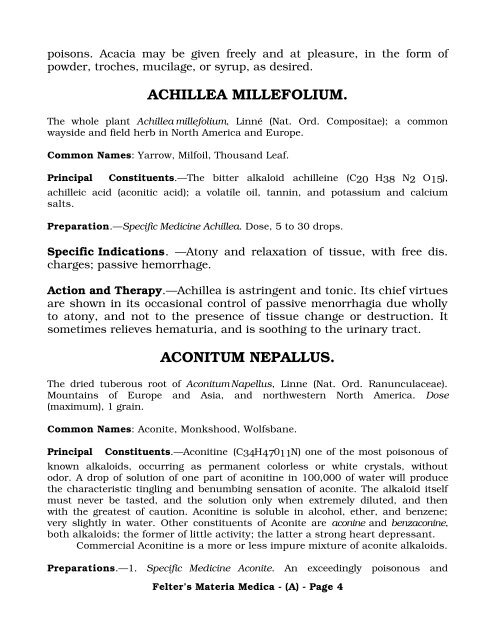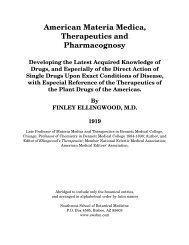Individual Drugs. ABIES (Tsuga canadensis). - Southwest School of ...
Individual Drugs. ABIES (Tsuga canadensis). - Southwest School of ...
Individual Drugs. ABIES (Tsuga canadensis). - Southwest School of ...
Create successful ePaper yourself
Turn your PDF publications into a flip-book with our unique Google optimized e-Paper software.
poisons. Acacia may be given freely and at pleasure, in the form <strong>of</strong><br />
powder, troches, mucilage, or syrup, as desired.<br />
ACHILLEA MILLEFOLIUM.<br />
The whole plant Achillea millefolium, Linné (Nat. Ord. Compositae); a common<br />
wayside and field herb in North America and Europe.<br />
Common Names: Yarrow, Milfoil, Thousand Leaf.<br />
Principal Constituents.—The bitter alkaloid achilleine (C20 H38 N2 O15),<br />
achilleic acid (aconitic acid); a volatile oil, tannin, and potassium and calcium<br />
salts.<br />
Preparation.—Specific Medicine Achillea. Dose, 5 to 30 drops.<br />
Specific Indications. —Atony and relaxation <strong>of</strong> tissue, with free dis.<br />
charges; passive hemorrhage.<br />
Action and Therapy.—Achillea is astringent and tonic. Its chief virtues<br />
are shown in its occasional control <strong>of</strong> passive menorrhagia due wholly<br />
to atony, and not to the presence <strong>of</strong> tissue change or destruction. It<br />
sometimes relieves hematuria, and is soothing to the urinary tract.<br />
ACONITUM NEPALLUS.<br />
The dried tuberous root <strong>of</strong> Aconitum Napellus, Linne (Nat. Ord. Ranunculaceae).<br />
Mountains <strong>of</strong> Europe and Asia, and northwestern North America. Dose<br />
(maximum), 1 grain.<br />
Common Names: Aconite, Monkshood, Wolfsbane.<br />
Principal Constituents.—Aconitine (C34H47011N) one <strong>of</strong> the most poisonous <strong>of</strong><br />
known alkaloids, occurring as permanent colorless or white crystals, without<br />
odor. A drop <strong>of</strong> solution <strong>of</strong> one part <strong>of</strong> aconitine in 100,000 <strong>of</strong> water will produce<br />
the characteristic tingling and benumbing sensation <strong>of</strong> aconite. The alkaloid itself<br />
must never be tasted, and the solution only when extremely diluted, and then<br />
with the greatest <strong>of</strong> caution. Aconitine is soluble in alcohol, ether, and benzene;<br />
very slightly in water. Other constituents <strong>of</strong> Aconite are aconine and benzaconine,<br />
both alkaloids; the former <strong>of</strong> little activity; the latter a strong heart depressant.<br />
Commercial Aconitine is a more or less impure mixture <strong>of</strong> aconite alkaloids.<br />
Preparations.—1. Specific Medicine Aconite. An exceedingly poisonous and<br />
Felter’s Materia Medica - (A) - Page 4
















